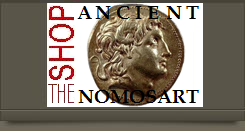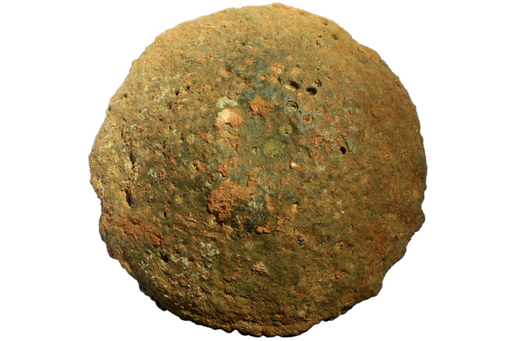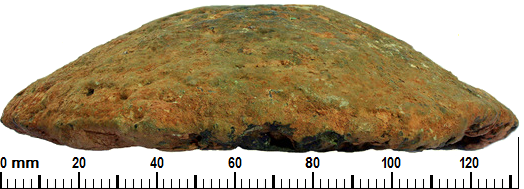
about ancient nomos
Ancient Nomos Art is a museum of galleries exhibiting ancient coins and ancient mint maps. The coin gallery displays the diverse art and history of hand-crafted ancient Greek, Roman, Byzantine, Persian and Medieval coinage. The ancient mints mapping gallery features Greek, Roman, Byzantine, Asia Minor and Medieval mint city regions and territories. Visitor's are welcome to explore, study and enjoy Ancient Nomos Art.

Roman Aes Formatum Ingot
6th-4th Century BC
From Ancient Galleries

Obverse: Truncated conical-shaped, round type "Aes Formatum" ingot.
Reverse: Flat (as originally cast) planar surface and blank.

DESCRIPTION
Obv: Aes Formatum bronze ingot, truncated conical-shaped, round type molded casting. Rev: Planar surface and blank.
Welcome to the dawn of ancient Roman coinage and cast bronze as bullion! The ancient cast bronze ingot above represents a very early example of Roman metal bullion first used as a medium for exchange by the burgeoning Republican Roman culture. Known today as “aes formatum” (formed bronze), these earliest of very large cast ingots, like coins, had both intrinsic, bullion and monetary value. The term aes formatum was first mentioned in the major study and 1910 publication of ancient Roman cast bronze coinage titled, Das Schwergeld Rom und Mittelitaliens, by Ernst Haeberlin, (see plate 2, images 7-8). In his major ancient Roman bronze study, the numismatist coined the Latin term aes formatum to describe the earliest formed-shape cast copper and bronze trade ingots. The Haeberlin aes formatum specimens can be seen on plates 3 and 4, and are identified as round “cakes”, bars, ax heads and even pieces of round castings that are broken.
The economic trade of a pure metal bullion object in the form of this very heavy bronze ingot, circa 4th century BC, came late to Roman culture and marks a very remarkable cultural accomplishment for the Republican Roman society. Early Republican society was essentially agricultural where barter and trade of products functioned as the primary medium of exchange among its citizens and neighbors. As the Republic expanded, the agricultural subsistence based economy alone was becoming unsustainable. Coincidentally, regional copper ore deposits were readily available in central Italy and had already been in extensive use by the Etruscan neighbors to the north. It is during this agrarian era that the Romans learned for the first time how bronze bullion could come to represent an “exchangeable” object of value, both economically and literally. Romans quickly learned bullion ingots could be traded, hoarded, stored, consumed, recycled, redistributed or used in a Pagan sacrifice. The use of bronze as bullion, permitted Romans to specialize, expand and provide purchasing power for citizens, soldiers and tradesmen, which could hold long term value well into the future. Many diverse forms, shapes and styles soon emerged for a wide range of various practical, symbolic, religious, economic or ideological ends. In addition, as Roman society expanded, knowledge of copper mining, smelting and mixing with tin to make bronze soon became integral to the burgeoning society.
The Roman knowledge and industry quickly incorporated the use of sophisticated technologies to mine ores including many different types of elemental deposits such as lead, silver and gold, in addition to copper and tin. The need for copper and copper products increased greatly after Pyrrhus of Epirus returned to Greece, circa 280 BC. After defeating the Greeks, the Romans controlled central and south Italy and within a century, would become the largest miners, refiners and producers of copper products in the Mediterranean. Virtually all early Republican bronze metalwork is characterized by practicality and simplicity of design which is emblematic of the ancient Roman metal casting methods and technology. It is these characteristically Roman conditions of pragmatism and austerity that give the early Republican coinage the seemingly crude mightiness and design simplification that display bold, powerful and perhaps somewhat “primitive” appearance.
During the 4th century BC and before Romans created coins, a progression or chronology of three basic cast bronze bullion types evolved. This is when the earliest copper and bronze bullion artifacts emerged as a means of exchange. The first type of smelted bronze bullion metal was cast by Romans into rough lumps of bronze known as “aes rude” (rough bronze) pieces of no precise weights and a variety of sizes. The second type of smelted bronze bullion was cast into regular molds of different shapes, but with precise weights. These are the aes formatum pieces like the specimen depicted above. The aes formatum specimens are generally cast without any type of inscription or images. Lastly, they were smelted and cast into rectangular bars of precise weights, but were cast with device inscriptions and or images. The latter cast ingots are known as “aes signatum” pieces. All three types of early bronze bullion objects, from an elemental point of view, are precious pieces of ‘heavy metal’ that have an intrinsic value because of their copper and tin content.
The archaeological evidence for this early Roman aes formatum bronze ingot as a mining smelting product and as a trade commodity is becoming more and more apparent through the number of ancient Roman sites and finds. Sites where the aes formatum bronze ingots have been discovered range from central Italy including, Aria, Cervetari, Cere, Etruria and in Porto Torres on the island of Sardinia. Sardinia is especially known by archaeologists to have had a highly developed bronze metalworking industry as is evident from many site finds of ingots, molds and bronze artifacts. Many of these bronze ingot find sites are recorded and referred to as in the: Garrucci 1885, Bahrfeld 1901, Willers 1905 and Haeberlin 1910. Similar aes formatum bronze ingots have also been discovered in Europe including, Gračac, Mazin, Štikada and Vrankamen, and also as far away as North Africa, Spain, Britain and the Near East, including China. The vast extent and wide range of aes formatum finds clearly demonstrates the importance, high value and long distances that interconnected the ancient Roman bronze trade beyond the Mediterranean. This wide range of bronze ingot finds throughout Mediterranean Europe directly coincides with the Republican Roman growth and expansion of trade and commerce during the late Bronze Age.
From an economic standpoint, the aes formatum bronze ingot above represents a critical transition stage of Roman currency. The ingot is a tangible artifact that links the mode of production, beginning with the ancient mining and smelting metalworkers, with the regional Republican era distribution corridors ultimately connected to the bronze consumers. While the ancient aes formatum bronze ingots come in a variety of shapes and sizes, the specimen above is a truncated conical-shaped ingot and is a unique variation of the usual round plano-convex discoid type. Many ancient Roman copper mining sites include the remains of blast furnace pits (ovens) offering valuable clues to the heating processes used to separate copper from the mined ores. During the heating process (smelting), copper mats formed at the bottom of the furnace pits. The raw copper was then reheated to a liquid and combined with approximately 10% tin to create the alloy bronze. The bronze was then cast into convenient size aes formatum ingots, stackable in sacks for transport and distribution. The finished aes formatum ingots generally had a weight ranging from one to two kilograms, though larger examples have been discovered. The raised surface is usually convex or conical, which was the surface in contact with the ground or bottom of the mold receiving the molten bronze. The flat surface of the aes formatum ingot was the area that was exposed to air while the molten bronze was cooling. In cross section, they are thickest at or near the center, then slope gradually towards the edges.
DOCUMENTATION
Value: 5 Asses (63 Unciae). Metal: Æ cast bronze. Weight: 1750 grams. Original (heavy) libral standard. Dated: 5th-4th century BC.
Attribution: Italo Vecchi. Italian Cast Coinage. London. 2013, page 84; Haeberlin, Aes Grave; Das Schwergeld Rom und Mittelitaliens, plate 2, #7-8; Lex Aternia-Tarpeia Libra from A. Gaius, Institutes, Book I, 122 (premonetale) Ex. Kent Ponterio Collection, Roman Republic RSSS, #38375; Harlan Berk Aes Formatum Inventory, 2000.
AES FORMATUM INGOT EDGE VIEW

SPECIAL FEATURE EXHIBIT
The ANAM Special Features gallery examines how the Frustum Formula can be used to understand, calculate and unlock the geometric volume and ancient Roman value of this extremely rare truncated conical-shaped aes formatum cast bronze ingot. To view the Republican Roman Aes Formatum Frustum Formula study in the Special Features gallery, please use the following link: Roman Aes Formatum Study Special Features Exhibit
Legend, Documentation and Attribution
